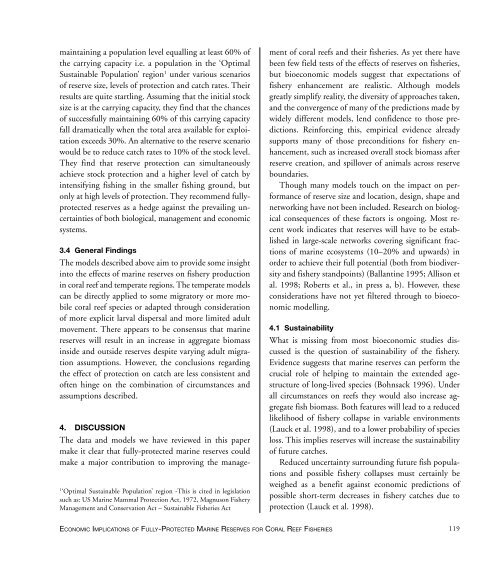You also want an ePaper? Increase the reach of your titles
YUMPU automatically turns print PDFs into web optimized ePapers that Google loves.
maintaining a population level equalling at least 60% <strong>of</strong><br />
the carrying capacity i.e. a population in the ‘Optimal<br />
Sustainable Population’ region 1 under various scenarios<br />
<strong>of</strong> reserve size, levels <strong>of</strong> protection and catch rates. Their<br />
results are quite startling. Assuming that the initial stock<br />
size is at the carrying capacity, they find that the chances<br />
<strong>of</strong> successfully maintaining 60% <strong>of</strong> this carrying capacity<br />
fall dramatically when the total area available for exploitation<br />
exceeds 30%. An alternative to the reserve scenario<br />
would be to reduce catch rates to 10% <strong>of</strong> the stock level.<br />
They find that reserve protection can simultaneously<br />
achieve stock protection and a higher level <strong>of</strong> catch by<br />
intensifying fishing in the smaller fishing ground, but<br />
only at high levels <strong>of</strong> protection. They recommend fullyprotected<br />
reserves as a hedge against the prevailing uncertainties<br />
<strong>of</strong> both biological, management and economic<br />
systems.<br />
3.4 General Findings<br />
The models described above aim to provide some insight<br />
into the effects <strong>of</strong> marine reserves on fishery production<br />
in coral reef and temperate regions. The temperate models<br />
can be directly applied to some migratory or more mobile<br />
coral reef species or adapted through consideration<br />
<strong>of</strong> more explicit larval dispersal and more limited adult<br />
movement. There appears to be consensus that marine<br />
reserves will result in an increase in aggregate biomass<br />
inside and outside reserves despite varying adult migration<br />
assumptions. However, the conclusions regarding<br />
the effect <strong>of</strong> protection on catch are less consistent and<br />
<strong>of</strong>ten hinge on the combination <strong>of</strong> circumstances and<br />
assumptions described.<br />
1<br />
‘Optimal Sustainable Population’ region -This is cited in legislation<br />
such as: US Marine Mammal Protection Act, 1972, Magnuson Fishery<br />
Management and Conservation Act – Sustainable Fisheries Act<br />
4. DISCUSSION<br />
The data and models we have reviewed in this paper<br />
make it clear that fully-protected marine reserves could<br />
make a major contribution to improving the management<br />
<strong>of</strong> coral reefs and their fisheries. As yet there have<br />
been few field tests <strong>of</strong> the effects <strong>of</strong> reserves on fisheries,<br />
but bioeconomic models suggest that expectations <strong>of</strong><br />
fishery enhancement are realistic. Although models<br />
greatly simplify reality, the diversity <strong>of</strong> approaches taken,<br />
and the convergence <strong>of</strong> many <strong>of</strong> the predictions made by<br />
widely different models, lend confidence to those predictions.<br />
Reinforcing this, empirical evidence already<br />
supports many <strong>of</strong> those preconditions for fishery enhancement,<br />
such as increased overall stock biomass after<br />
reserve creation, and spillover <strong>of</strong> animals across reserve<br />
boundaries.<br />
Though many models touch on the impact on performance<br />
<strong>of</strong> reserve size and location, design, shape and<br />
networking have not been included. Research on biological<br />
consequences <strong>of</strong> these factors is ongoing. Most recent<br />
work indicates that reserves will have to be established<br />
in large-scale networks covering significant fractions<br />
<strong>of</strong> marine ecosystems (10–20% and upwards) in<br />
order to achieve their full potential (both from biodiversity<br />
and fishery standpoints) (Ballantine 1995; Allison et<br />
al. 1998; Roberts et al., in press a, b). However, these<br />
considerations have not yet filtered through to bioeconomic<br />
modelling.<br />
4.1 Sustainability<br />
What is missing from most bioeconomic studies discussed<br />
is the question <strong>of</strong> sustainability <strong>of</strong> the fishery.<br />
Evidence suggests that marine reserves can perform the<br />
crucial role <strong>of</strong> helping to maintain the extended agestructure<br />
<strong>of</strong> long-lived species (Bohnsack 1996). Under<br />
all circumstances on reefs they would also increase aggregate<br />
fish biomass. Both features will lead to a reduced<br />
likelihood <strong>of</strong> fishery collapse in variable environments<br />
(Lauck et al. 1998), and to a lower probability <strong>of</strong> species<br />
loss. This implies reserves will increase the sustainability<br />
<strong>of</strong> future catches.<br />
Reduced uncertainty surrounding future fish populations<br />
and possible fishery collapses must certainly be<br />
weighed as a benefit against economic predictions <strong>of</strong><br />
possible short-term decreases in fishery catches due to<br />
protection (Lauck et al. 1998).<br />
ECONOMIC IMPLICATIONS OF FULLY-PROTECTED MARINE RESERVES FOR CORAL REEF FISHERIES<br />
119


















